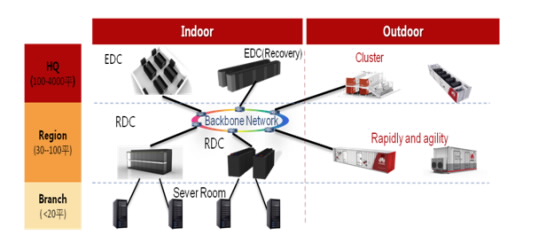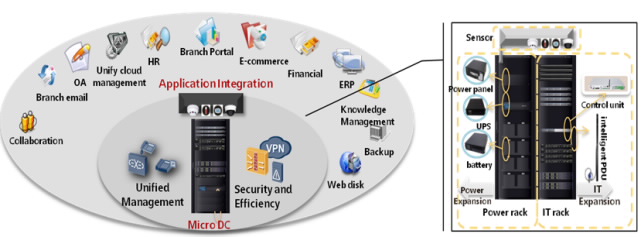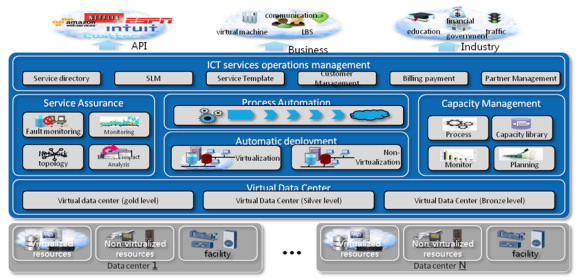Solución de centros de datos de empresa
The Huawei EDC solution uses a modular design and loose coupling between basic infrastructure modules and service modules to ensure dynamic service expansion and rapid service rollout.
The Huawei EDC solution design features specific hardware, software, and applications to provide a simple and reliable IT infrastructure, which is easy to deploy, manage, expand, and upgrade. The Huawei EDC gives users better investment protection and meets EDC visualized and unified management and control requirements for creating, upgrading, and expanding the EDC.
Through global economic integration, the enterprise has been increasingly integrated into the global economy. Companies face commercial globalization and comprehensive transformation challenges. Enterprise decision-makers must resolve the problems of how to flexibly respond to market changes and improve operational efficiency, while optimizing costs and deepening market insight. Many businesses, most notably Chinese enterprise groups, face rapid growth that co-exists with such problems as inadequate management and control, low operational efficiency, slow market responses, and other challenges. In the era of cloud computing, the Chief Information Officer (CIO) must be mindful of the need to lead enterprise transformation and upgrades in terms of information technology, timely pursuit of effective corporate strategies, business requirements, and traditional enterprise IT resource upgrade to reform the enterprise IT.
The data center, as the core exchange and control center for IT systems, plays an essential role in the enterprise, also faces many challenges—and many opportunities:
- How can the data center flexibly adapt to rapid business growth by providing timely, effective IT support?
- How can the data center adapt to the new business model of fast, scalable IT resources and flexible management?
- How can the data center optimize costs, protect IT assets, and improve operational efficiency?
- How can the data center improve energy efficiency, reflecting corporate environmental responsibilities, through the implementation of green IT initiatives?
- How can the data center meet ever-increasing availability requirements and control risks to ensure business continuity?
Huawei deeply understands the challenges faced by enterprises. By studying its own IT transformation experience, Huawei understands how to achieve an agile data center that can help manage business transformation. Huawei combines this knowledge with end-to-end solutions that help enterprises comprehensively fulfill IT and data center demands to meet such challenges as fast business growth, agile operations, and resource optimization.
Huawei Enterprise Data Center (EDC) solutions transform the original architecture to simplify IT cloud computing and build an agile enterprise. Huawei wants to help enterprises to fully use existing IT investments and seamlessly upgrade to advanced cloud computing, a philosophy that supports flexible enterprise information development.
Scene
As large-scale business expansion explode, data is increasing exponentially. Enterprise demands to construct new data centers or upgrade capacities are likewise increasing. To adapt, IT departments must quickly deploy data centers, while cutting investment risks and optimizing operational costs.
Summary
To resolve the paradox between customers' changing needs and the need for low business investments with high returns, Huawei has launched a new modular data center solution. The solution satisfies demands for high-density power, rapid deployment, flexible expansion, and higher data center efficiency to control investment costs. Modular rack, power distribution, refrigeration, monitoring, management, maintenance, and security systems enable seamless integration of the power supply, cooling, and management components.
The modular data center can meet customer requirement for indoor and outdoor environments.
- Micro Sever Room: Integrated cabinets, cooling, power supply, monitoring system take up less than 20 square meters. The solution deploys 1-5 racks, with power density of 2-20 kW, for use in branch wiring closets, network rooms, workstations, and other environments.
- Small Sever Room: Single or double packages require less than 250 square meters and deploy 6-28 racks with 30-270 kW power density. This solution can be applied to branches, regional data centers, or data centers at headquarters.
- Mid-Sized Data Center: Several modules and auxiliary systems are deployed in 28-1,000 racks, with a power density of 30-270 kW, for use in such scenarios as large corporate headquarters’ data centers.

Figure: Modular Data Center Solution Schematic Diagram
Highlights
- Rapid deployment: Factory prefabricated components and on-site rapid assembly reduce deployment cycle to 8–12 weeks and shorten construction time by more than 50 percent.
- Green energy-savings: A sealed cold/hot channel technology prevents the mixing of the cold and hot air, significantly reducing energy consumption by 30–50 percent and Power Usage Effectiveness (PUE) as low as 1.25.
- Flexible expansion: Modular components and a unified interface standard allow on-demand capacity by rack or module units, saving investment and maintenance costs.
Scenario
With global expansion, enterprise tentacles extend all over the world. When new branches expand, IT capabilities must be established quickly. New branch IT capacities must meet requirements for dynamic flexibility, short deployment time, low specification requirements, and efficient maintenance.
Summary
The Huawei Micro Data Center solution features an integrated micro data center that incorporates power supply/distribution devices, cabinets, heat dissipation modules, network devices, servers, security devices, Cloud Operating Systems (OSs), and integrated management software. This solution is the only product that centrally monitors and manages equipment room ambient environments and IT infrastructures. Device pre-installation enables service provisioning within one day. Remote monitoring allows the group headquarters to perform unified management and equipment rooms in branches to operate properly, even when unattended.
Huawei Micro Data Center solutions have been used in the company’s own branches, implementing more than 100 server-rooms transformation projects.

Figure : Micro Data Center Solution Schematic Diagram
Highlights
- Standardized, highly integrated design simplifies the procurement process and enable unified management.
- Global unified operation and maintenance, and centralized remote control, help enterprises achieve unattended operation and standardization, reducing Operating Expenditures (OPEX) by 30 percent.
- Capital Expenditures (CAPEX) are reduced up to 10 percent. Branch server rooms can be easily moved and set up via plug-and-play technology, speeding deployment and improving efficiency by more than 50 percent.
- Hierarchical and decentralized management provide remote and local administrators flexible management, enabling automatic system protection, data backup, and disaster recovery.
Scenario
Managers need to obtain timely overview information, and IT departments need to manage the cloud platform, use automated IT operation and maintenance, and utilize cross-platform management tools.
Summary
The Huawei ManageOne data center management solution integrates business operations and infrastructure maintenance to provide comprehensive data center operations and service management. In addition to traditional infrastructure virtualization, Operation and Maintenance (O&M), and service management, the Huawei ManageOne solution also provides business support to carrier, enterprise, government, and other industrial customers, according to industry business requirements. ManageOne can resolve slow market reactions, difficult system introduction, long deployment cycles, and other problems for industrial customers. The ManageOne data center management solution includes:
- Business support system for public cloud, private cloud, and hybrid cloud.
- Unified operation and management solution for data center facilities and infrastructure.
- Distributed, multi-level data center management solution.
Through the deployment of the Huawei ManageOne solution, IT staff can unify and decentralize management authority for the Enterprise Data Center (EDC), Remote Data Center (RDC), and SR via the unified management portal, and also could enhance management efficiency and reduce Operation and Maintenance (O&M) costs. The ManageOne solution helps enterprise protect IT investments, achieving simplified management and operational agility.

Figure : ManageOne Solution Diagram
Highlights
- Centralized portal mask for different interface management tools creates a unified enterprise approach.
- Integration of cloud products across the cloud and non-cloud IT environments achieves comprehensive data center operation management.
- Centralized Operation and Maintenance (O&M) platform integrates daily monitoring and O&M information, optimizing processes, supporting virtualization, improving resource utilization by 40 percent, and cutting reducing O&M costs by 50 percent.
- All monitoring technology and O&M solutions are open standard, making support possible for the comprehensive management of millions of nodes.
Scenario
Due to the continuous development of enterprises and business growth, data centers have become scattered and IT resources have become decentralized, stifling information sharing. Through data center consolidation, enterprises can improve of information sharing, improve management, enhance business continuity and improve resource utilization.
Summary
Relying on expertise and experience, Huawei provides data center consolidation solutions and services to its customers, including data center transfer, capacity expansion, and integration.
- Network architecture consolidation, network convergence consolidation, and multiple data center network consolidation
- Physical server consolidation and logical consolidation
- Storage consolidation
- Security consolidation
- Data center management consolidation
- Data center environmentally-friendly energy conservation consolidation
- Data center assessment services: architecture, network, server, storage security, server room, and management
- Consolidation tools: assessment tools (information-collection tool and capacity-planning tool), design tool, and migration tool.
Highlights
- Shortens time to prepare IT resources for new business from a few months to a few days or hours.
- Reduces risks and management complexity, improve business Service Level Agreement (SLA) via centralized data center monitoring and management.
- Reduces operating expenditures by up to 60 percent, primarily through consolidating the diverse data center manufacturing brands and platforms.
- Saves 20–50 percent of power consumption by reducing the number of data centers and improving IT equipment utilization.
